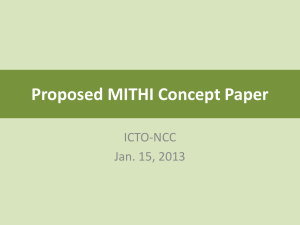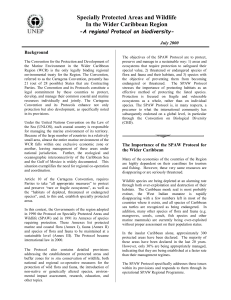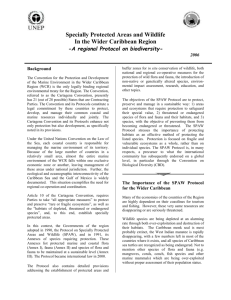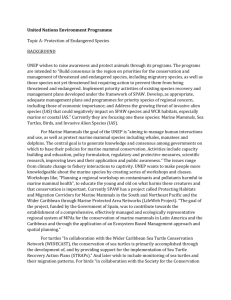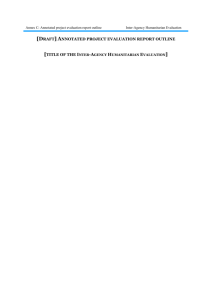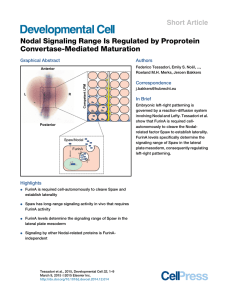Criteria for the Selection of Flora and Fauna
advertisement
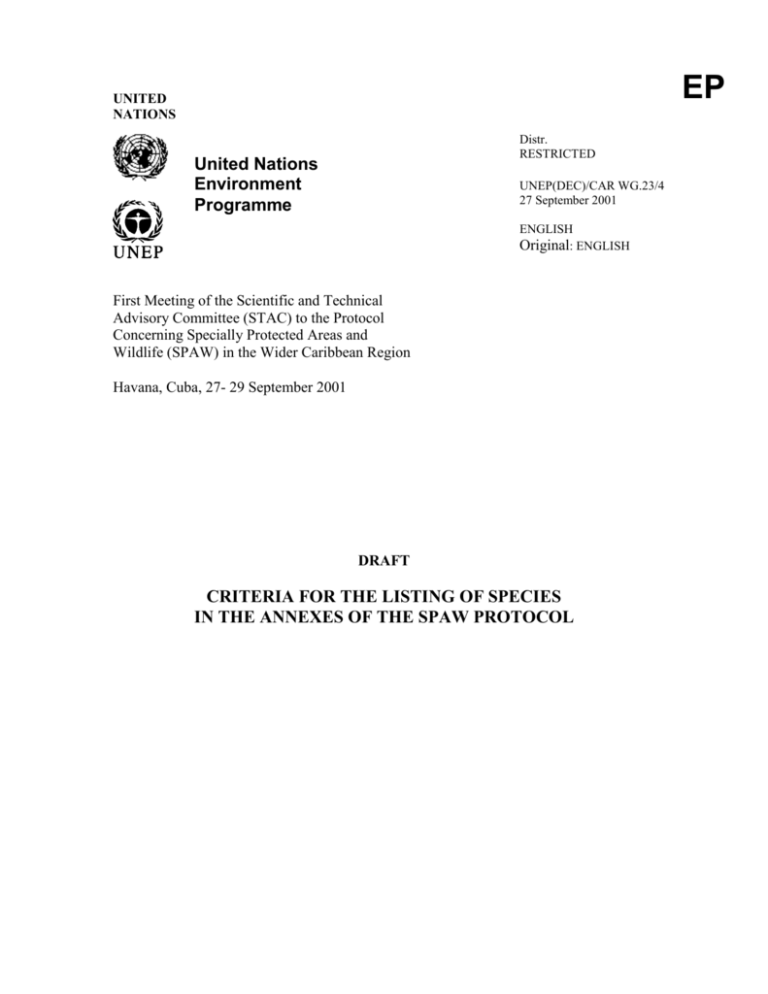
EP UNITED NATIONS Distr. RESTRICTED United Nations Environment Programme UNEP(DEC)/CAR WG.23/4 27 September 2001 ENGLISH Original: ENGLISH First Meeting of the Scientific and Technical Advisory Committee (STAC) to the Protocol Concerning Specially Protected Areas and Wildlife (SPAW) in the Wider Caribbean Region Havana, Cuba, 27- 29 September 2001 DRAFT CRITERIA FOR THE LISTING OF SPECIES IN THE ANNEXES OF THE SPAW PROTOCOL UNEP(DEC)/CAR WG.23/4 Page 1 Draft Criteria for the Listing of Species in the Annexes of the SPAW Protocol Introduction Article 21 of the SPAW Protocol calls for the Contracting Parties to evaluate and adopt common guidelines and criteria formulated by the Scientific and Technical Advisory Committee (STAC), dealing, inter alia with the identification and selection of protected species. Article 11(4) of the SPAW Protocol outlines the procedures for amending the lists of species in the Annexes to the Protocol. One of the requirements outlined includes the need to take into account the advice of the STAC to ensure that the nomination of species meets the common guidelines and criteria established under Article 21 (Article 11(4)(c)). In turn, Article 20 on the establishment of the STAC requests that the Committee advises the Parties through the Secretariat on scientific and technical matters such as the listing of protected species, in keeping with the provisions of Article 11 and with the formulation of common guidelines and criteria in keeping with Article 21 (Article 20(3)(b)) and (3)(f)). At the Conference of Plenipotentiaries for the Adoption of the Annexes to the Protocol Concerning Specially Protected Areas and Wildlife (SPAW Protocol), Kingston, 10-11 June 1991, the Parties endorsed the criteria which had been used by the Ad Hoc Group of Experts for the selection of flora and fauna for inclusion in the Annexes of the Protocol (Martinique, 5-8 November 1990). Furthermore, the Conference decided that at the next meeting of the Group of Experts, these criteria were to be reviewed, and if appropriate, recommended modifications and/or additions were to be submitted for approval to the First Meeting of the Contracting Parties to the SPAW Protocol. In light of the fact that a group of experts has yet to meet on this matter, and given the above requirements of the Protocol, it is one of the functions of STAC to review these criteria prior to their approval by the Parties. The Secretariat is therefore presenting herewith said criteria as the basis for the review and comments by the First Meeting of the Scientific and Technical Advisory Committee (STAC) with a view to make any pertinent modifications or additions, considering the recommendations of the 1991 Conference of Plenipotentiaries, as well as those made by SPAW Contracting Parties in preparation for this Meeting. Criteria for the listing of species in the Annexes of the SPAW Protocol used by the Conference of Plenipotentiaries on the Adoption of the Annexes: (a) For the purpose of all three annexes, the scientific evaluation of the "threatened or endangered" status of the proposed species is to be based on the following factors: UNEP(DEC)/CAR WG.23/4 Page 2 size of the populations, evidence of decline, restrictions on range, and the importance of the species to the maintenance of fragile and vulnerable ecosystems; (b) Whether the species is the subject of trade and whether international trade is regulated under CITES; (c) Given the wide definition of the territorial ambit of the Protocol under Article 1(c) and the particular circumstances of the region, listing will not be limited to marine and coastal species; (d) Given the regional, co-operative nature of the protection to be accorded to listed species, species endemic to only one country are generally not regarded as appropriate for listing, these species being more appropriate for protected status under Article 10 of the Protocol. In certain cases where international co-operation is considered important in recovery efforts, endemic species are to be included in the lists; (e) Given that the listing of a taxonomic unit is agreed to cover all the lower taxa, higher taxa are utilized, where appropriate, to simplify the lists and to address the problems caused by species of similar appearance. The listing of species is taken to include all sub-species and as a general rule, sub-species are not recommended for separate listing; and (f) In the case of species essential to the maintenance of fragile and vulnerable ecosystems (such as mangrove forests, seagrass beds and coral reefs), the listing of such species are felt to be "appropriate measure to ensure the protection and recovery" of the ecosystem which they constitute, and hence to fulfil the requirements for listing under Article 11 (1) (c) of the Protocol. Because these systems as a whole are subject to anthropogenic changes, as well as large-scale natural disturbances (such as the consequences of sea-level and temperature rise induced by global warming), appropriate protection should be focused on the system as a whole, rather than on individual specimens. This approach is thought to be appropriate to foster comprehensive national and regional policies for managing these fragile and threatened ecosystems. _____________________________________________________________ Definitions in the SPAW Protocol: (a) "Endangered species" are species or sub-species of fauna and flora, or their populations, that are in danger of extinction throughout all or part of their range and whose survival is unlikely if the factors jeopardizing them continue to operate. (b) "Threatened species" are species or sub-species of fauna and flora, or their populations: (i) that are likely to become endangered within the foreseeble future throughout all or part of their range if the factors causing numerical decline or habitat degradation continue to operate; or (ii) that are rare because they are usually localized within restricted geographical areas or habitats or are thinly scattered over a more extensive range and which are potentially or actually subject to decline and possible endangerment or extinction. UNEP(DEC)/CAR WG.23/4 Page 3 At the 1991 Conference of Plenipotentiaries, the Parties also agreed: (a) That the provisions of Article 11 of the Protocol should not apply to specimens legally acquired prior to the entry into force of the Protocol or to their progeny; (b) That species listed under Annex III may be utilized on a rational and sustainable basis, but require management for their protection and conservation. Not all of the conservation measures set forth in Article 11(l)(c) may be appropriate for all species. The measures listed in Article 11 (1)(c) are illustrative of the measures that each Party could adopt. Management of Annex III species may include, but is not limited to, the conservation measures identified in Article 11 (1)(c); (c) That the mechanisms specified in the Convention on International Trade in Endangered Species of Wild Fauna and Flora (CITES) may be used to govern international trade in wild fauna and flora under Article 11 of the Protocol; (d) That the provisions and obligations of the Protocol do not apply to non-native species, defined as species found outside of their natural geographical distribution, as a result of deliberate or incidental human intervention; (e) That the attribution of responsibility for complying with the substantive obligations of the Protocol will be effected by each Party according to its own constitutional and administrative system. Comments received from SPAW Contracting Parties Following the requests made by the Secretariat to the Contracting Parties to the SPAW Protocol regarding comments for the agenda of the First Meeting of the Contracting Parties (COP) and the First Meeting of the Scientific and Technical Advisory Committee (STAC) in preparation for these Meetings, the Government of Cuba provided the following comments regarding the species listing criteria: Criterion a: The success of the national management programmes gives some guarantee of the state of conservation of the species, therefore these programmes should be included among the factors to be considered for a complete scientific evaluation of the “threatened or endangered” status of a species proposed to be included in the Annexes. On the other hand, modern assessment criteria such as quantitative analysis of the probability of extinction, as well as the fragmentation of populations, introduced species, etc. should be incorporated. In light of the above we consider that the criterion should be developed in the following manner: UNEP(DEC)/CAR WG.23/4 Page 4 (a) for the purpose of the three Annexes, the scientific assessment of the condition of “threatened or endangered” status of the proposed species should be based on the following factors: size of populations; evidence of decline; restrictions on its range of distribution or fragmentation of the populations; quantitative analyses of probability of extinction; effect of introduced taxa; hybridization; pathogens; pollutants; competitors or parasites; importance of the species for the management of fragile and vulnerable ecosystems; levels of exploitation and evaluations and national management and assessment programmes. Criterion b To include any species in the Annexes, one of the principal aspects to be considered is its social value, both the traditional uses as well as the non-traditional ones, in order to ensure that the Protocol has a solid social base and that the conservation of the species does not become separated from the human dimension. The social and human dimension is not adequately considered in the valuation the species, which are to be included in the Annexes. The criterion should be drafted in the following manner: (b) The social value of the species, their traditional and non-traditional uses, which may or may not be the object of trade; and said trade has a negative impact on the conservation of the species in the region. Criterion c: This criterion contradicts the wording of the Protocol and it is not clear which are the species that really belong to the scope of application of the Protocol. Its wording must be revised by the Contracting Parties in order to clearly define its scope and link to the radius of action of the Protocol. In their analysis the Contracting Parties should consider that given the characteristics of the states of the region, the criterion should make a distinction between insular states and continental ones, as well as when defining its scope for those species which are not coastal nor marine. Criterion d: In principle, endemic species should not be included in a Protocol which is regional in nature. The protection of endemic species is the responsibility of each Contracting Party and should be resolved through their internal legislation. The criterion should be drafted in the following manner: UNEP(DEC)/CAR WG.23/4 Page 5 (d) Given the regional nature of the SPAW Protocol, it is not considered appropriate to include in the lists species which are endemic to a single country. Any Contracting Party may request the inclusion on the lists of a species that is endemic to their territory, if regional cooperation is deemed important for the recovery efforts. Criterion e: The lists should not be prepared at the level of higher taxa. By not delimiting at the level of the sub-species, we run the risk of including sub-species of the same taxon that are not threatened. The criterion should be drafted in the following manner: (e) The lists should be prepared at the level of species and/or sub-species. The higher taxa shall only be used when there is scientific certainty that all the lower taxa are in equal or similar conditions. Criterion f: We do not propose any modifications. CRITERIA AND GUIDELINES USED FOR DRAFTING THE ANNEXES In keeping with the elements which are outlined below: 1. That the guidelines and criteria used for the drafting of the initial Annexes, as well as the initial Annexes themselves, were adopted at the Conference of Plenipotentiaries of the CEP over ten years ago. 2. That there is no correspondence between the regional nature of the SPAW Protocol and the species listed in its Annexes, many of which are endemic. 3. Due to the length of time which transpired between the adoption and entry into force of the SPAW Protocol, the initial Annexes only constitute an approximation to the complex issue of conservation of the flora and fauna of the coastal ecosystems of the region and do not reflect the reality of the evolution dynamics of the listed species, therefore it may be necessary to include new species or remove some of those already listed. 4. That in accordance with the provisions of Articles 24 of the Cartagena Convention and 21.1(a) of the SPAW Protocol, the Contracting Parties to this Protocol have the sole and exclusive right to revise and adopt as final, both the criteria and guidelines used, as well as the Annexes themselves. We consider it necessary that a mandate be given to the STAC, so that on the basis of the Common Guidelines and Criteria for the selection of the species adopted by the Conference the Parties, the STAC evaluates the lists of the initial Annexes and presents a proposal of Definitive Annexes to the next Conference of Parties.
